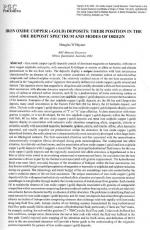Добрый день, Коллеги. Важное сообщение, просьба принять участие. Музей Ферсмана ищет помощь для реставрационных работ в помещении. Подробности по ссылке
Iron oxide copper (-gold) deposits: their position in the ore deposit spectrum and models of origin / Месторождения железоокисной меди (-золота): их положение в спектре рудных месторождений и модели происхождения
Iron oxide copper (-gold) deposits consist of dominant magnetite or haematite, with one or more copper sulphides and pyrite, with associated K-feldspar or sericite or albite or biotite and chlorite predominant in the ore host rocks. The deposits display a unique association with host successions characterised by an absence of, or by very minor occurrence of, elemental carbon or reduced-carbon compounds and reduced-sulphur minerals. The relatively oxidised nature of the ore host succession is reflected in the "magnetically active" signature that usually defines iron oxide copper (-gold) mineralised districts. This signature shows that magnetite is ubiquitous and variably abundant within ore host successions. Host successions with discrete domains respectively characterised by (a) by rocks with an absence or rarity of carbon or reduced carbon minerals, and (b) by a predominance of rocks containing carbon or reduced carbon minerals, however, contain iron sulphide-copper (-gold) deposits on or near the boundaries of the domains. Examples of the iron sulphide-copper (-gold) deposits are the Mt Isa and Gunpowder deposits, many small occurrences in the Eastern Fold Belt (Mt Isa Inlier), the El Soldado deposit, and others. The iron oxide copper (-gold) deposits and the iron sulphide copper (-gold) deposits display a more distant association with near coeval granites of "I" or "A" type affinities. A close association with these granites is cryptic, or is not developed, for the iron sulphide-copper (-gold) deposits within the Western Fold Belt, Mt Isa Inlier. All iron oxide copper (-gold) deposits and most iron sulphide copper (-gold) deposits display an association with extensive sodic alteration comprising albite, magnetite, chlorite or actinolite, usually with associated scapolite, haematite, epidote, calcite, and titanite. Albite, often haematite pigmented, and usually scapolite are predominant within the alteration. In iron oxide copper (-gold) mineralised districts, the sodic alteration is characteristically most intensively developed within large faults and on lithological contacts. The fault-associated alteration and that associated with the mineralisation characteristically overprints fabrics developed during peak metamorphism. The widespread late albite alteration, its relatively oxidised nature, and the association of iron oxide copper (-gold) and iron sulphide copper (-gold) deposits with it suggests a causal link. The principal hydrothermal fluid source for the iron oxide copper (-gold) deposits and the regionally associated late albite alteration, is hypothesised to be a brine or saline water stored in an overlying extensional or transtensional basin, its circulation into the host successions is driven in part by the thermal event associated with granite emplacement. The hydrothermal fluids were most likely non-acid, because of the abundance of feldspar within the host successions, but they became acid through coupled precipitation of magnetite or haematite or sulphides and sulphate reduction during ore genesis. The mineralogy and metal budget of the ore assemblage were also controlled by the relative oxidation states of the ore host succession. The unique association of iron oxide copper (-gold) deposits with the widespread and relatively oxidised albite alteration and specific host succession mineral assemblages is inexplicable through models that invoke sources of metals alone from granites. Such models fail to explain the absence of iron oxide copper (-gold) deposits associated with granites of comparable composition within successions comprising dominant reduced-carbon-bearing rocks, or which are relatively non-reduced, but are characterised by an absence of albite alteration. The problems in identifying fluid and metal sources for iron oxide copper (-gold) deposits, and for many ore deposits has arisen through excessive reliance on studies of isotope ratios comprising elements that exchange relatively rapidly with host rocks along long fluid flow path. Isotope studies of ore forming systems characterised by long hydrothermal fluid flow paths usually fail to identify sources of hydrothermal fluid, particularly if there are "hot" rocks, for example, cooling, but sub-solidus granites (T < 700°C) in the fluid flow path. Under rock-buffered hot rock conditions, isotope ratios characterise the last or later rock with which the fluid was buffered in the flow path. Careful regional scale mapping of the alteration and its Na/K ratios, and definition of Br/CI ratios in the ore-associated alteration will provide a better guide to the understanding of the enigmatic systems responsible for genesis of iron oxide copper (-gold) deposits.




